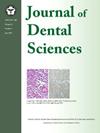扫描体夹板对全弓数字种植体印模精度的影响
IF 3.1
3区 医学
Q1 DENTISTRY, ORAL SURGERY & MEDICINE
引用次数: 0
摘要
背景/目的口腔内扫描仪捕捉全弓种植体印模的准确性仍然是一个正在进行的研究课题。本研究旨在评估不同扫描策略和夹板扫描体对下颌骨全数字扫描精度的影响。材料与方法采用四种植体无牙下颌骨模型。种植体被放置在双侧下颌侧切牙和第二前磨牙区域。利用实验室扫描仪对参考模型进行数字化处理。采用A组(单阶段扫描)、B组(两阶段扫描,不附加参考文献)和C组(两阶段扫描,附加参考点)三组不同的扫描策略和辅助参考方法对扫描精度的影响。结果共分析了45张数字扫描图。为了评估扫描精度,在四个种植体位置测量线性偏差,并与数字参考模型进行比较。A组在所有种植体位置上的总体平均线性偏差最小,为39.57±8.69 μm。B组的平均偏差略高,为42.80±24.24 μm。C组线性偏差最大(70.60±17.69 μm),与A、B组比较差异均有统计学意义(P < 0.05)。本研究的结果表明,单级扫描可以获得更高的精度,而结合设计不良或定位不当的参考标记可能会无意中损害扫描精度。本文章由计算机程序翻译,如有差异,请以英文原文为准。
Impact of scan body splinting on the accuracy of complete-arch digital implant impressions
Background/purpose
The accuracy of intraoral scanners in capturing complete-arch implant impressions remains a subject of ongoing investigation. This study aimed to evaluate the influence of different scanning strategies and the effect of splinting scan bodies on the accuracy of complete digital scans of the mandible.
Materials and methods
A master model of an edentulous mandible with four dental implants was used. The implants were positioned bilaterally in the regions of the mandibular lateral incisors and second premolars. A laboratory scanner was utilized to digitize the reference model. Three experimental groups were used to evaluate the effects of different scanning strategies and auxiliary reference methods on scan accuracy: Group A (single-stage scan), Group B (two-stage scan without additional references), and Group C (two-stage scan with additional reference points).
Results
A total of 45 digital scans were analyzed. To evaluate scan accuracy, linear deviations were measured at the four implant sites and compared against the digital reference model. Group A consistently demonstrated the highest accuracy, with the lowest overall mean linear deviation of 39.57 ± 8.69 μm across all implant positions. Group B recorded a marginally higher mean deviation of 42.80 ± 24.24 μm. Group C showed the greatest linear deviation (70.60 ± 17.69 μm), and the differences were statistically significant when compared with both Groups A and B (P < 0.05).
Conclusion
The findings of this study indicate that single-stage scanning yields superior accuracy, whereas the incorporation of poorly designed or improperly positioned reference markers may inadvertently compromise scan precision.
求助全文
通过发布文献求助,成功后即可免费获取论文全文。
去求助
来源期刊

Journal of Dental Sciences
医学-牙科与口腔外科
CiteScore
5.10
自引率
14.30%
发文量
348
审稿时长
6 days
期刊介绍:
he Journal of Dental Sciences (JDS), published quarterly, is the official and open access publication of the Association for Dental Sciences of the Republic of China (ADS-ROC). The precedent journal of the JDS is the Chinese Dental Journal (CDJ) which had already been covered by MEDLINE in 1988. As the CDJ continued to prove its importance in the region, the ADS-ROC decided to move to the international community by publishing an English journal. Hence, the birth of the JDS in 2006. The JDS is indexed in the SCI Expanded since 2008. It is also indexed in Scopus, and EMCare, ScienceDirect, SIIC Data Bases.
The topics covered by the JDS include all fields of basic and clinical dentistry. Some manuscripts focusing on the study of certain endemic diseases such as dental caries and periodontal diseases in particular regions of any country as well as oral pre-cancers, oral cancers, and oral submucous fibrosis related to betel nut chewing habit are also considered for publication. Besides, the JDS also publishes articles about the efficacy of a new treatment modality on oral verrucous hyperplasia or early oral squamous cell carcinoma.
 求助内容:
求助内容: 应助结果提醒方式:
应助结果提醒方式:


